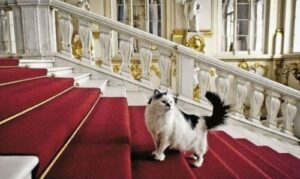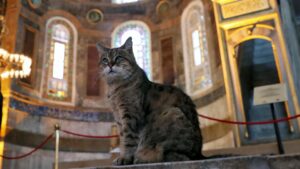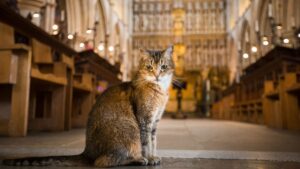The concept of “heritage,” while commonly used in reference to artwork, can also apply to living beings. This includes animals who occupy certain social and cultural functions. Today’s post explores a unique phenomenon in cultural institutions: the role of cats.

One of the Hermitage Cats (courtesy of beautifulrus.com)
Cats have been the subject of fascination – and even worship – for humans since ancient times. In Egypt, the cat-headed goddess Bastet was renowned as a protector. The Temple of Bastet, a 2,200-year-old temple in the city of Bubastis, yielded a treasure hoard in 1906, comprised of gold and silver items. Nowadays, felines can be found protecting cultural institutions in the flesh – or rather, fur. For instance, the Hermitage Museum in St. Petersburg, Russia has a population of approximately 50 cats in its basement, which has hosted feline residents since the mid-1700s. Empress Catherine the Great bestowed them with the status of guardians of the art galleries, as a gesture of gratitude for their eradication of rodents from the premises. The museum’s cats have become extremely popular with the local community, giving rise to the Day of the Hermitage Cat initiative in 1999. Over 800 photographs and prints were submitted and displayed in 2020 as part of the annual tradition. But these cats have captured hearts abroad as well. Recently, a French philanthropist left a provision for the cats in his will. The funds will likely be used to repair their basement home, ensuring that the cats will have shelter for years to come.

Gli in Hagia Sophia (courtesy of TRT Worldwide)
Other cities have also embraced cats as heritage guardians. Rome has supported its feline population by officially declaring that they form part of the city’s “bio-cultural heritage.” The law of the surrounding Lazio region states that stray cats have the right to stay wherever they are born, and are entitled to food and medical assistance. Notably, the worship of cats reached ancient Rome from Egypt; legend has it that these denizens accompanied Cleopatra on her visit to the Eternal City. Cats were particularly valued by the Romans since they helped curb rodent-borne diseases, such as the bubonic plague. Currently, the archaeological site of Torre Argentina – where Julius Caesar was famously murdered – has hosted a Cat Sanctuary since 1993. A revolving group of “cat ladies,” or gattare, from various countries provide the residents with food and care. Interested individuals can even “distance adopt” one of these historical strays. This “suburban oasis” has become a vital part of the community and attracted the patronage of actors, diplomatic families, and even a former opera singer. In the words of the Sanctuary, these “aristocratic cats rule over their temples with pride.” The Protestant Cemetery, the final resting place of Romantic poets John Keats and Percy Bysshe Shelley, has another dedicated sanctuary where cats have a peaceful place to roam. The cats provide an interactive experience for visitors while drawing in donations for the site’s upkeep, thanks to a charitable organization.

Doorkins Magnificat (photo courtesy of CNN)
Perhaps not surprisingly, religious institutions have also welcomed four-legged visitors. This past October, London’s Southwark Cathedral laid to rest Doorkins Magnificat, a former street cat who found a home in the church in 2008. As one might expect from a cat with such an illustrious name, Doorkins was well-loved by visitors, congregants, and clergy; she even met Queen Elizabeth II. As a mainstay of the community, Doorkins found fame in a range of church-sponsored merchandise – including a children’s picture book – and had her own Twitter account with thousands of followers. Doorkins’ farewell was streamed online, and it was the first service held for a cat in the illustrious history of the cathedral. The Hagia Sophia in Istanbul, Turkey also lost its internationally-acclaimed resident cat, Gli, this year. Gli was born in the museum and received much attention on social media and national news channels. She was considered a local celebrity and received a visit from former U.S. President Barack Obama in 2009, gaining over 130,000 followers on Twitter. Upon her death, the beloved cat received thousands of tributes by fans and art historians before being buried on site.